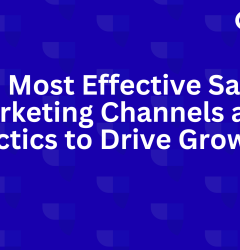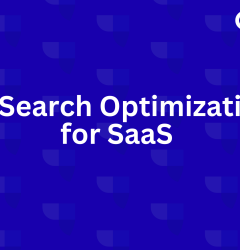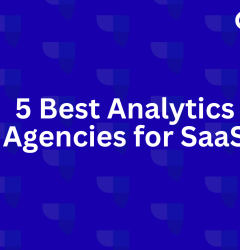19 Feb

Published by: Amit Kakkar
Published on: February 19, 2025
Last updated on: November 8, 2025
Last Updated on November 8, 2025 by admin
Do you know that there are over 30,000 SaaS companies worldwide?
And it’s very unlikely that they don’t have a stunning website on Google. But does every one of them consistently rank on Google? No!
The tricky thing with SaaS is that it has a very high customer acquisition cost with a brutally competitive market and risks of volatile customer preferences. You will have to beat the competitors with high-tech features, prove your product credibility, and acquire new customers while retaining the existing ones. Most importantly, your product should be visible to the target audience when they search for product-related buyer keywords.
Even if you have an outstanding product, you won’t be able to acquire users unless you are visible at the right places to the right audience online. That is where SaaS SEO plays a crucial role.
SaaS SEO not only boosts your online visibility but also establishes your brand authority, builds credibility, gives you a competitive edge, engages users, and converts website visitors into paying customers. You get all this at a fraction of the cost if your SEO is done right and you are ranking on Google. Therefore, reducing your customer acquisition costs while ensuring long-term MRR growth.
This blog explores the 10 ways to rank your SaaS website on Google and boost your organic traffic and eventually conversion rates.
What Is Different about SaaS SEO?
SaaS SEO processes are similar to SEO we do for any other website. You will need keywords, SEO-optimized blogs, case studies, landing pages, and lots of backlinks.
The difference is how you incorporate your product in the SEO strategies to achieve your marketing goals.
For example, a blog on project management for a SaaS website will not just talk about how to coordinate with your team better and give tips on tracking work progress and meeting milestones. Instead, it will highlight the problems that teams currently face in collaborating and managers struggle to effectively assign and monitor tasks. Then the blog will present their SaaS product as an ideal solution to these challenges.
Therefore, the blog not only informs the target audience but also caters to their pain points and offers a solution while being SEO optimized. This is what we mean by a SaaS SEO-friendly blog post.
Moving forward, the top 3 secrets to ranking your SaaS product on Google are :
- Publish product-led content: Blog posts, podcasts, webinars, and eBooks should show how to solve a problem with your product. Each content piece should have an end goal leading people to sign up for your product.
- Giveaway free tips and resources: You can share templates that users can integrate within your product or break down workflows for building something innovative with your platform that users might not know. A great way to introduce a new feature!
- Turn your product into SEO content: Launch baby versions of your product for free on a landing page with target buyer keywords. The best way to rank, attract customers, and get them to sign up to explore more.
More tips are coming your way in the next section.
Top 10 Ways To Rank Your SaaS Website On Google
Here are the top 10 ways to do SaaS SEO and rank your website on Google.
1. Do Competitor & Market Research
Don’t straight jump to keyword research or content strategy. Do your research first. You must have done market research before building your product. Now it’s time to do another research for SEO and marketing purposes.
For effective research, find answers to the following questions :
- What is trending in your market?
- Who are your competitors?
- What are your competitors offering?
- How are they marketing their SaaS product?
- What SEO strategies are they employing?
- What type of content are they publishing?
- Who is your target audience?
- What are their pain points?
- How can your product resolve those pain points?
- Where is your target audience most active?
- What are the deciding factors that convince them to sign up?
- Do they trust reviews, testimonials, or case studies?
- What are your customers exactly looking for when it comes to your product?
Once you have answers to these questions, you will know the approach you need to take with your SaaS SEO.
2. Find Potential Keywords With Traffic
The most important step to rank your SaaS product we see on Google is to find the right keywords.
Most SaaS companies depend on their competitors to get their first set of keyword lists and topic clusters. This is okay. And okay will not get you ranks. Coming up with your ideas is what will make you different from others.
- Target keywords with low competition and high volume.
- Make a list of your seed keywords or buyer keywords.
- Then go on to dissect your main buyer keywords to get a list of the nearest related keywords.
- Focus on semantic keywords for building authority in your content.
- Always focus on keyword intent while shortlisting and categorizing them.
- Make content pillars and categorize your keywords accordingly. (For example, keywords for blogs, landing pages, comparison pages, and educational content)
3. Publish Product-led content to rank and convert.
General content will not get you anywhere. Your content should show how your product solves the problems of the target audience and why they should consider signing up.
To get a better idea, dive into the blogs of ClickUp, Ahrefs, and Semrush to see how their content incorporates products. The trick is to subtly include the product in the content so that the readers don’t feel forced to use the product. But they get an idea of how the product will easily cater to their pain points.
4. Use programmatic SEO to generate traffic at scale
In traditional SEO, each keyword is targeted with a manually created, unique page. Programmatic SEO, however, takes a different approach—targeting an entire topic with dozens or even hundreds of similar pages, generated automatically or semi-automatically.
A well-known example is Zapier, which leveraged programmatic SEO to capitalize on branded search demand for over 6,700 apps they integrate with. Their app pages follow a nearly identical structure, with only minor text variations and a dynamically generated list of automation tasks for each app.
The key to programmatic SEO is identifying scalable keywords, such as :
- Similar keywords with multiple variations (e.g., “SEO for realtors,” “SEO for caterers,” etc.).
- Keywords with a common theme that fit within a structured content directory. For example, you could create a glossary of industry terms or a data hub showcasing insights relevant to your audience—like a directory of top-performing SEO pages.
By identifying patterns in search demand, programmatic SEO allows businesses to scale their content efforts efficiently while driving targeted organic traffic.
5. Offer a “Baby Version” of Your SaaS For free
The simple way to rank a SaaS website on Google – launch a baby version of your product for free. This will not only help you easily rank for the buyer keywords but also increase your CTR. Also, it is the best way to impress your target audience because actions speak louder than words.
No matter how much you talk about your product on blogs and social media, it cannot beat the convincing power when people use it themselves.
Most importantly, it will give customers a sneak peek of your product and what it can do. Therefore, you may receive some signups from visitors who are impressed with your product and want to use the full version.
For instance, you can see how Semrush, Ahrefs, and Taplio offer free tools, which are junior versions of their products.
6. Create Content For Each Stage in the Customer Journey
Another best way to rank your SaaS product on Google is to define your customer journey so they are never left wondering at any stage.
In SaaS SEO, aligning your content with the different stages of the marketing funnel is crucial for driving relevant traffic and conversions. To achieve this, start by identifying target keywords that relate to the problems your product solves.
There are four main types of keywords to consider:
- Informational Keywords – Used by searchers looking to learn more about a topic (e.g., “What is cloud-based project management?”).
- Commercial Keywords – Indicate interest in exploring products or services (e.g., “Best project management tools for remote teams”).
- Transactional Keywords – Show purchase intent, as the searcher has decided on a solution and wants to take action (e.g., “Buy [SaaS product] subscription” or “Sign up for [SaaS tool] free trial”).
Navigational Keywords – Used when a searcher is looking for a specific page or website (e.g., “Asana pricing” or “Notion login”).
By strategically targeting these keyword types in your content strategy, you can effectively guide potential customers through each stage of the funnel—from awareness to conversion.
7. Pages to describe each feature of your product
You have got an amazing product but it’s time to tell people what it’s capable of. That is why you need pages for every feature of your product.
- Don’t shy away from describing all the things your product can do.
- Did deeper into your product features and functionalities.
- Make a list of features or things users can do with your product.
- Then find relevant keywords for each feature page.
Canva, for instance, is the best example of this strategy. You can make any design with Canva, from resumes to infographics, videos, posters, and more. And their SEO team decided to cover everything on their website. This gives you the opportunity to target lots of high-intent buyer keywords and highlights your product’s skills to your visitors.
How Can Growthner Help You Rank Your SaaS Product?
Ranking a SaaS product on Google requires a strategic blend of SEO, content marketing, and technical optimization. Growthner specializes in helping SaaS companies achieve higher search rankings by implementing data-driven SEO strategies tailored to their industry.
Here’s how we can help :
- Comprehensive keyword strategy focused on high-impact informational, commercial, and transactional keywords to align with your marketing funnel.
- Programmatic & scalable SEO to create hundreds of optimized pages that target long-tail keywords, branded searches, and competitor comparisons.
- High-quality, product-led, and SEO-optimized blogs, landing pages, and pillar content designed to boost authority and engagement.
- Technical SEO, site optimizations, internal linking, and crawlability enhancements to fine-tune your website for maximum search visibility.
- Link building from reputable sources, strengthening your domain authority, and improving your rankings.
- Performance tracking through in-depth analytics and reporting, ensuring your SEO strategy evolves based on real-time performance insights.
By combining these proven SEO tactics, Growthner helps SaaS companies like yours gain higher rankings, increased organic traffic, and more conversions.
Ready to rank? Let’s get started!







Amit Kakkar